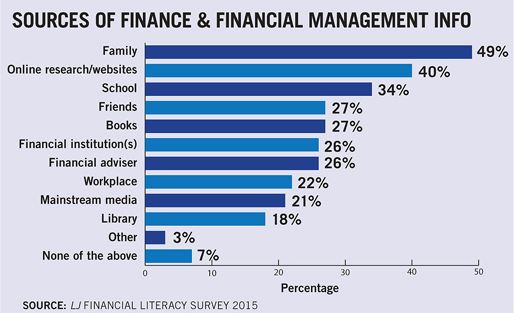
As the variety of program topics increases in public libraries, financial literacy training has emerged as a common topic in many libraries, especially since the recession. Financial literacy training seeks to educate and provide strategies about how to manage one’s money and prepare for financial planning. Yet Library Journal’s 2015 Financial Literacy Survey suggests that these services are not being used by cardholders as much as they could be.
Out of 10 options, libraries ranked last as a source of financial information among the 1,466 library cardholders surveyed across 230 libraries. Just under one-fifth (18%) of those surveyed ranked it as a possible source, even though well over half (61%) of librarians surveyed said that they offered financial services.
Library Journal proposes that the biggest challenge to public libraries is actually getting the word out about financial literacy training, since their survey indicated that more people would likely attend these events if only they knew about them. More than half (55%) of those surveyed said they would be willing to attend financial programming if they knew about it, and in addition to that an overwhelming majority (87%) said they trust financial information they receive from public libraries.
The good news is that any public library can create financial literacy programming that is both inexpensive and appeals to patrons. One librarian surveyed was able to put on a week-long programming event for just $200. The survey also found that programming that integrated financial training for children saw higher attendance, a proactive strategy that helps to develop financial literacy early on in life while also opening up conversation among adults.
Get ideas for how your public library can jump-start its financial literacy programming, and read the full report, here.
Note: This post is part of our series, “The Weekly Number.” In this series, we highlight statistics that help tell the story of the 21st-century library.